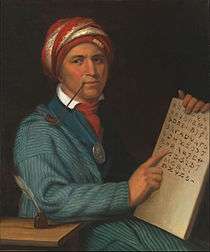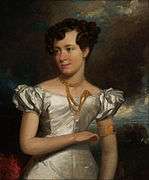Henry Inman (painter)

Henry Inman (October 20, 1801 – January 17, 1846) was an American portrait, genre, and landscape painter.
Biography
He was born at Utica, N.Y., and was for seven years an apprentice pupil of John Wesley Jarvis in New York City, along with John Quidor.[1][2] He was the first vice president of the National Academy of Design. He excelled in portrait painting, but was less careful in genre pictures. Among his landscapes are Rydal Falls, England, October Afternoon, and Ruins of Brambletye. His genre subjects include Rip Van Winkle, The News Boy, and Boyhood of Washington. His portraits include those of Henry Rutgers and Fitz-Greene Halleck in the New York Historical Society. He also painted portraits of Angelica Singleton Van Buren, Bishop White, Chief Justices Marshall and Nelson, Jacob Barker, William Wirt, Audubon, DeWitt Clinton, Martin Van Buren, and William H. Seward.
Thomas L. McKenney assigned Inman, who was an accomplished lithographer, the task of copying more than a hundred oil paintings of Native American leaders by Charles Bird King to translate into a printed book, the History of the Indian Tribes of North America.[3] The oil paintings are now in the collections of White House, the Joslyn Art Museum, and the Amon Carter Museum of American Art, among others. In the Metropolitan Museum, New York, are his Martin Van Buren, The Young Fisherman, and William C. Maccready as William Tell
During a year spent in England in 1844–1845, he painted Wordsworth, Macaulay, John Chambers, Sir William Stewart, Baronet of Blair and other celebrities. He returned to America in failing health, and at the time of his death, January 17, 1846, was engaged on a series of historical pictures for the Capitol at Washington.
Among his pupils was the portraitist and still life painter Thomas Wightman.
- Paintings by Henry Inman
 Portrait of David Vanon (c. 1832–33)
Portrait of David Vanon (c. 1832–33)_-_Google_Art_Project.jpg) Portrait of Angelica Singleton Van Buren (c. 1842), White House Collection
Portrait of Angelica Singleton Van Buren (c. 1842), White House Collection Portrait of Sequoyah (c. 1830), Smithsonian's National Portrait Gallery
Portrait of Sequoyah (c. 1830), Smithsonian's National Portrait Gallery Portrait of Clara Fisher (c. 1828), Indianapolis Museum of Art
Portrait of Clara Fisher (c. 1828), Indianapolis Museum of Art Portrait of a Woman (c. 1825), Brooklyn Museum
Portrait of a Woman (c. 1825), Brooklyn Museum_-_Google_Art_Project.jpg) Portrait of No-Tin (Wind) (c. 1832-33), Los Angeles County Museum of Art
Portrait of No-Tin (Wind) (c. 1832-33), Los Angeles County Museum of Art- Portrait of Cornelia Rutgers Livingston (c. 1833), New Britain Museum of American Art
 Portrait of Mrs. William Samuel Johnson (c. 1823), Yale University Art Gallery
Portrait of Mrs. William Samuel Johnson (c. 1823), Yale University Art Gallery
References
- ↑ Roger Panetta, ed. (2009). Dutch New York: the roots of Hudson Valley culture. Hudson River Museum. pp. 223–235. ISBN 978-0-8232-3039-6.
- ↑ Caldwell, John; Rodriguez Roque, Oswaldo (1994). Kathleen Luhrs, ed. American Paintings in the Metropolitan Museum of Art. Volume I: a Catalogue of Works by Artists Born By 1815. Dale T. Johnson, Carrie Rebora, Patricia R. Windels. The Metropolitan Museum of Art in association with Princeton University Press. pp. 479–482.
- ↑ Gerdts, William. The Art of Henry Inman.
 This article incorporates text from a publication now in the public domain: Gilman, D. C.; Thurston, H. T.; Colby, F. M., eds. (1905). "article name needed". New International Encyclopedia (1st ed.). New York: Dodd, Mead.
This article incorporates text from a publication now in the public domain: Gilman, D. C.; Thurston, H. T.; Colby, F. M., eds. (1905). "article name needed". New International Encyclopedia (1st ed.). New York: Dodd, Mead.
External links
| Wikimedia Commons has media related to Henry Inman. |
- Art and the empire city: New York, 1825-1861, an exhibition catalog from The Metropolitan Museum of Art (fully available online as PDF), which contains material on Inman (see index)
- Gallery of Henry Inman's works, Art Authority